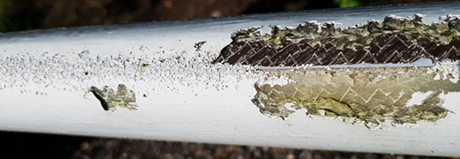Velux Fonden project PREMISE “Preventing MIcroplastics pollution in SEa water from offshore wind”
- Objectives:
- Evaluate the size and volume of the problem. How much plastics lands in the sea? Quantifying volume, size distributions and shape characteristics of microplastics formed from each material group, used for the blade coatings.
- Evaluate environmental risk and toxicological effects, for each group of polymers. How potentially toxic is each group of polymers? What is fate of various microplastics coming from wind turbines?
- Future solutions. Promising ways to mitigate erosion and their pollution risks. Guidelines to the reduction marine pollution.
-
Innovation Foundation (IFD) project WiseWind/NeW generatIon of SustainablE Wind turbine Blades”:
- Objective: The WISEWIND project focuses on developing new blade materials, which will ensure re-processability, easy reparability and repeated recyclability of blades. New generation of recyclable wind turbine blades, based on vitrimer resins, is developed, on the basis of a digital twin of blade materials “from cradle to cradle”.
- Some publications:
Innovation Foundation (IFD) project DURALEDGE/”Durable leading edges for high tip speed wind turbine blades”:
- Objective: The objective of the DURALEDGE project is to understanding themechanisms of leading edge erosion of wind turbine blades, and to develop new new highly durable protective coatings and guidelines for the coating development. Partners: Vestas, Siemens Gamesa, LM Wind Power, Hempel, Covestro, DTU

- Some publications: L. Mishnaevsky Jr.,et al. Leading edge erosion of wind turbine blades: Understanding, prevention and protection, Renewable Energy, 2021; S.D. Rad, L. Mishnaevsky Jr, Leading edge erosion of wind turbine blades: Computational modelling, Wind Energy,, 23/8,; K. M. Jespersen et al,, 2020, On the potential of particle engineered anti-erosion coatings for leading edge protection. IOP Conference Series. 942, ; L. Mishnaevsky Jr. et al, Micromechanisms of leading edge erosion of wind turbine blades: X-Ray tomography analysis, Wind Energy 2019;1–16; L. Mishnaevsky Jr., Toolbox for optimizing anti-erosion protective coatings , Wind Energy 2019;1–18; L. Mishnaevsky Jr., J. Sütterlin, Micromechanical model of surface erosion of polyurethane, Polymer Degradation and Stability Vol. 166, 2019; S.D. Rad, L. Mishnaevsky Jr. Rain erosion of wind turbine blades, Meccanica, 55
EUDP (Energy Technology Development and Demonstration Program) project IEA Wind Task 45: Wind Turbine Blade Recycling (2022-2024, 1.3 Mio DKK)
The sustainability and recyclability of wind turbines became especially important due to the ageing and decommissioning of wind turbines installed in the 2000s. While 90% of wind turbine structures are recyclable and reusable, the recycling of polymer composites-based blades remains a significant challenge for the wind energy industry. To address this problem, the IEA Wind TCP Task 45 international network is built around three multi-disciplinary topics: 1) the technical aspects of recycling, waste prevention, reuse, and recycling technology; 2) integrated life cycle assessment and value chains, sustainable business models, and circular economy; and 3) standardization, certification, and legislation. The aim is to identify, explore, influence, and support decisions through exchange of information, analysis, and targeted dissemination of results.
Link: https://windenergy.dtu.dk/english/research/research-projects/iea-wind-tcp-task-45-wind-turbine-blade-recycling
Conferences: International Conference on Sustainable Wind Turbine Blades: New Materials, Recycling and Future Perspectives, November 21-23, 2022, Roskilde, Denmark.
Link: https://www.conferencemanager.dk/recyc

US-Danish collaborative project (DTU, New York University, Tufts University) "Structural health monitoring and maintenance of wind turbine blades", 2020-2022
